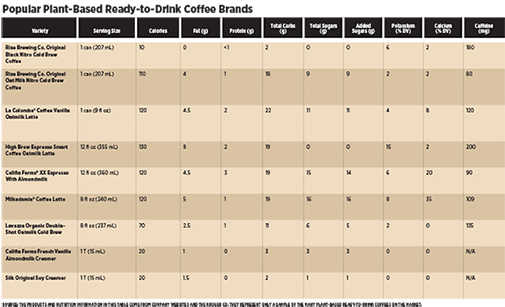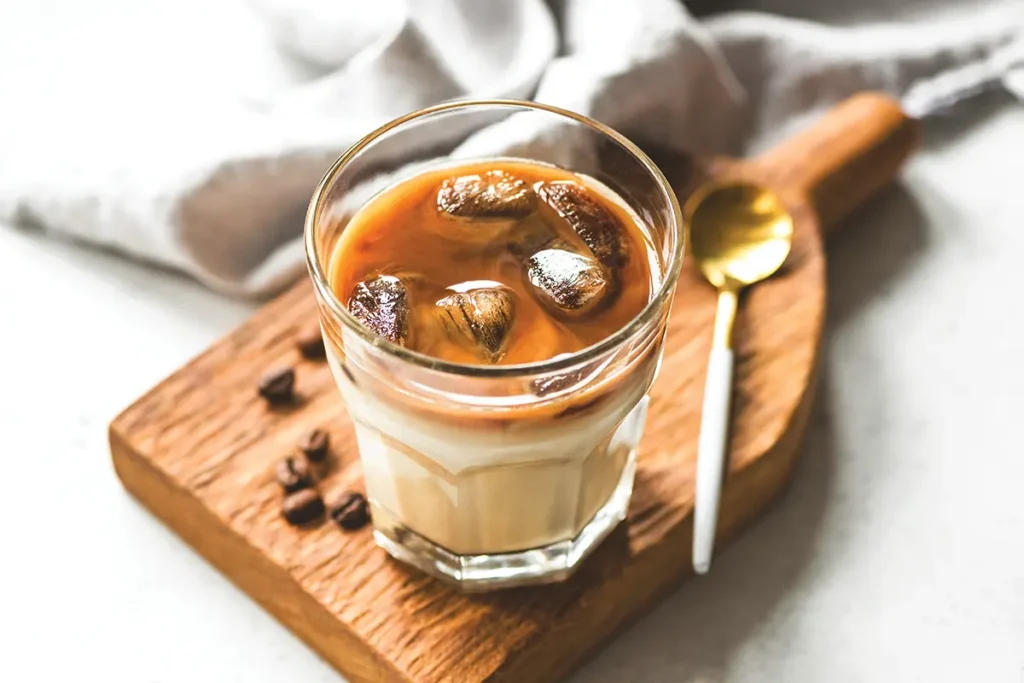Today’s Dietitian
Vol. 26 No. 2 P. 6
Dietitians are aware of two beverage categories that continue to increase independently in market share: alternative milks and cold coffees. The million-dollar question is: “What do consumers get when these products are combined?” Creamy, delicious, and convenient beverages that offer those seeking plant-based products more options, plus a whole new grocery category called dairy-free ready-to-drink (RTD) coffees.
RTD coffee made with plant-based milk is available in cans, glass or plastic bottles, and cartons. From canned nitro coffee with oatmilk and bottled cold brew coffee with almondmilk to boxed coffee latte with macadamia milk, 100% plant-based RTD coffees have become a trend of this decade.
“Ready-to-drink coffee remains the fastest growing segment of the coffee category, and increasingly the options are featuring plant-based milks,” says Janet Helm, MS, RD, a Chicago-based dietitian and global food culture analyst. More than 36% of RTD coffee consumers say their ideal RTD coffee would contain nondairy milk, according to Mintel.1
This article turns the spotlight on what’s driving the popularity of dairy-free RTD coffees, as well as the nutrients and functional ingredients they contain, and provides counseling strategies for RDs.
Driving the Trend
What’s fueling the growth of the dairy-free RTD coffee category is consumer demand for on-the-go convenience, the emergence of cold coffee trends, and the popularity of plant-based milk alternatives, Helm says, adding that “Plant-based RTD coffees are especially popular with Gen Z, who’s helping shape coffee culture.”
In fact, cold coffee is the preferred coffee drink of Gen Z, according to Mintel’s US Coffee and RTD Coffee Market Report 2023, with 57% of Gen Z consumers opting for cold coffee instead of hot.2 Furthermore, about 60% of Gen Zers born between 1997 and 2012 point to TikTok as their inspiration for drinking a cold cup of joe. Millennials concur that cold coffee is superior but also want a side of functionality with their brew.
Helm agrees, “Newer RTD coffees are touting functional benefits, including nootropics for brain health, protein, probiotics, and even relaxation—which seem counterintuitive for a coffee drink.”
Ted Gelov, CEO of Heartland Food Products Group, a global leader in the consumer packaged goods industry, headquartered in Carmel, Indiana, predicts, “The cold brew coffee category is expected to have double-digit growth for the foreseeable future.”
Java House, a company specializing in RTD cold brew coffee cafes in greater Indianapolis, sells a wide variety of RTD cold brew coffees to its patrons as well as cold brew pods, coffees in multiserve bag-in-box servings and 8-oz bottles online.
RTD coffees are more appealing to those short on time and possibly money. RTD coffee sold at retail outlets tends to be a couple of dollars less compared with those sold fresh at cafés.
The RTD coffee market currently is valued at $32.6 billion annually and is expected to grow at the compound annual growth rate of 5.7% from 2023 to 2032, according to MarketResearch.Biz.3 Plant-based creamer is the third largest plant-based category after milk and meat, according to the Plant Based Foods Association.4 This category grew by 24% in dollars and 12% in units, while animal-based creamer dropped by 1.4%. Popular plant-based milk bases include oat, almond, soy, and coconut.
While dairy-free RTD coffees may be appropriate for people with lactose intolerance and those seeking vegan and lower-fat options, they differ nutritionally.
Nutrition Content and Benefits
Plain, unsweetened cold-brewed coffee is naturally low in calories, fat, protein, and carbs, but swapping cow’s milk with dairy alternatives adds new factors to consider.
Protein is reduced by about half in most dairy-free versions—excluding soy, which is comparable to cow’s milk. Potassium content ranges from 2% to 16% DV, whereas calcium ranges from 2% to 35%, depending on whether or not the product is fortified. Of the dairy-free RTD coffees examined by Today’s Dietitian (see Table), none was fortified with vitamin D, which differs from cow’s milk that’s usually fortified with vitamin D.5
Most dairy-free RTD coffees contained added sugars, ranging from 6 g to 16 g per serving and most came from cane sugar. Califia Farms French Vanilla Almondmilk Creamer, for example, contains 3 g added sugars per tablespoon. Silk Original Soy Creamer contains 1 g added sugars per tablespoon.
Drinks with 0 g added sugars were sweetened with monkfruit and erythritol. La Colombe boasts 4 g fiber, coming from added chicory root fiber. La Colombe also adds canola oil for a creamier texture. Dairy-free RTD coffee brands typically use thickeners such as gellan gum and guar gum, plus a touch of sea salt to bring out natural flavors.

Functional Ingredients
Dairy-free cold-brewed coffee brands also are including functional ingredients Millennials are seeking for added health benefits.
For example, Austin, Texas-based High Brew Coffee, a company that distributes its products to 15,000 sales points in the United States, recently introduced Smart Coffee to its dairy-free portfolio. The coffee contains MCT oil and l-theanine, which, according to package claims, “helps fuel the mental processes by enhancing focus and concentration.” It also contains Cognizin citicoline, a “brain health ingredient”; has omega-3s and omega-6s; and is considered a good source of vitamin B12.
Cold Brew Oatmilk Lattes from San Francisco, California-based company Pop & Bottle offer varieties with unique ingredients, such as adaptogens, lion’s mane, and collagen. Adaptogens are active ingredients coming from plants and mushrooms that help the body handle stress, anxiety, and fatigue.6 Lion’s mane, a delicious, furry-looking mushroom variety, may help reduce stress and improve speed of mental performance,7 and collagen adds protein.
Another ingredient that most RTD coffees contain, with or without dairy, is caffeine. Of the brands examined, all of the caffeine is naturally occurring from the coffee beans—not added separately—which sets these beverages apart from the many canned energy drinks on the market.
Caffeine content ranges from 80 mg per 7 fl oz to 135 mg per 8 fl oz. For comparison, an 8-oz cup of coffee contains 96 mg.8
Counseling Clients
Over the next few years, consumers can expect to see more food and beverage companies entering the growing category of plant-based RTD coffees, Helm says. Technavio predicts that the US RTD coffee market will grow by nearly 8% from 2022 to 2027.9 When there’s growth, further innovation and unique selling propositions follow suit.
For clients who enjoy the convenience and taste of dairy-free RTD coffees, dietitians can discuss varieties that best fit their nutritional needs, taste preferences, and budget. Specifically, keep the following coffee characteristics in mind and how they might fit into a client’s overall diet:
• added sugars;
• calcium and potassium; and
• caffeine.
If clients struggle to find prepackaged coffee drinks that appeal to them, RDs can recommend a more DIY approach. For people who prefer a more subtle sweetness level, they can add a plant-based creamer to a can of unsweetened cold brew coffee to better control the amount of sugar they consume instead of relying on the manufacturer. It’s as easy as cracking open a can of coffee and (carefully) pouring in a small amount of creamer, to taste.
Or, they can choose a multiserve bottle of cold brew coffee instead of a can. “I love cold brew coffee, but when it comes to packaged varieties, I’m more likely to get a larger container to keep in my fridge instead of single-serve cans,” Helms says.
The dairy-free RTD coffee category will only continue to expand. As dietitians, it’s important, and even a bit entertaining, to stay abreast of what’s on the market in this new class of beverages.
— Michelle Dudash, RDN, is a Cordon Bleu-certified chef, author of Clean Eating Kitchen: The Low-Carb Mediterranean Cookbook (Fair Winds Press, 2021), and creator of Spicekick® Seasoning Mix, a line of gluten-free, no-added-sugar seasoning mixes. Follow her at @michelledudash.
References
1. Functional benefits top off attributes US consumers look for in ready-to-drink cold coffee. Mintel website. https://www.mintel.com/press-centre/functional-benefits-top-off-attributes-us-consumers-look-for-in-ready-to-drink-cold-coffee/. Published September 25, 2018.
2. Bryant C. US coffee and RTD coffee market report. Mintel website. https://store.mintel.com/report/us-coffee-and-rtd-coffee-market-report#accordion-subheading-1-product-description
3. Ready to drink coffee market by packaging (canned, glass bottle, PET bottle, other packaging), by distribution channel (supermarkets/hypermarkets, convenience stores, foods services, online), by region and companies – industry segment outlook, market assessment, competition scenario, trends, and forecast 2023-2032. MarketResearch.biz website. https://marketresearch.biz/report/ready-to-drink-coffee-market/. Published July 2023.
4. Plant-based foods state of the marketplace 2022 summary report. Plant-Based Foods Association website. https://www.plantbasedfoods.org/2022-u-s-retail-sales-data-for-the-plant-based-foods-industry/
5. Cow’s milk and milk alternatives. Centers for Disease Control and Prevention website. https://www.cdc.gov/nutrition/infantandtoddlernutrition/foods-and-drinks/cows-milk-and-milk-alternatives.html#:~:text=Most%20cow%27s%20milk%20sold%20in,beverages%20can%20have%20added%20sugars. Updated May 20, 2022.
6. Adaptogens. Cleveland Clinic website. https://my.clevelandclinic.org/health/drugs/22361-adaptogens. Updated February 10, 2022.
7. Docherty S, Doughty FL, Smith EF. The acute and chronic effects of lion’s mane mushroom supplementation on cognitive function, stress and mood in young adults: a double-blind, parallel groups, pilot study. Nutrients. 2023;15(22):4842.
8. Coffee, brewed. U.S. Department of Agriculture, Agricultural Research Service website. https://fdc.nal.usda.gov/fdc-app.html#/food-details/1104137/nutrients. Published October 30, 2020. Accessed December 11, 2023.
9. Ready to drink coffee market analysis North America, Europe, APAC, South America, Middle East and Africa – US, Japan, China, Germany, UK – size and forecast 2023-2027. Technavio website. https://www.technavio.com/report/ready-to-drink-coffee-market-analysis. Published October 2023.



